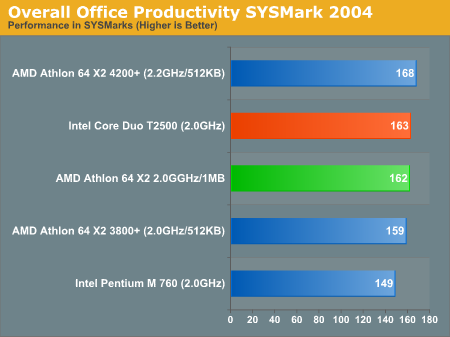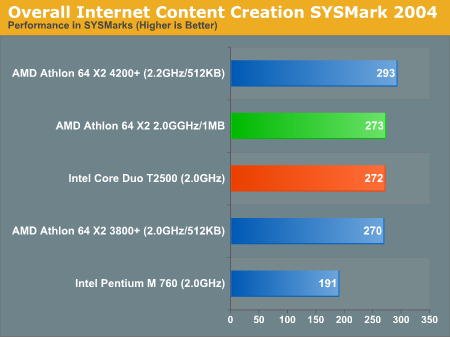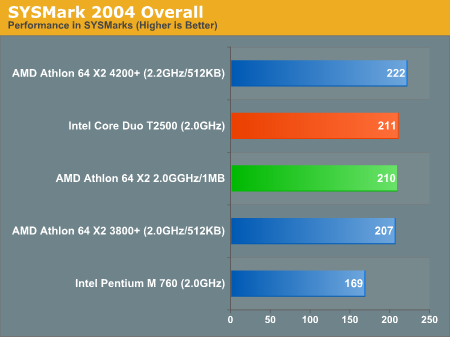Intel Core Duo (Yonah) Performance Preview - Part II
by Anand Lal Shimpi on December 19, 2005 12:55 PM EST- Posted in
- CPUs
Overall System Performance using SYSMark 2004
Office Productivity SYSMark 2004
SYSMark's Office Productivity suite consists of three tests, the first of which is the Communication test. The Communication test consists of the following:
Compared to the Athlon 64 X2, the Core Duo T2500 manages to slightly outperform the X2 3800+, but moving to a larger cache helps the X2 narrow that already small gap. Even though the Core Duo has a one-point lead, given the percentage, we'd call this one a tie.
The breakdown of the Office Productivity SYSMark 2004 score is listed below, higher numbers mean better performance:
ICC SYSMark 2004
The first category that we will deal with is 3D Content Creation. The tests that make up this benchmark are described below:
The breakdown of the ICC SYSMark 2004 score is listed below, higher numbers mean better performance:
Office Productivity SYSMark 2004
SYSMark's Office Productivity suite consists of three tests, the first of which is the Communication test. The Communication test consists of the following:
"The user receives an email in Outlook 2002 that contains a collection of documents in a zip file. The user reviews his email and updates his calendar while VirusScan 7.0 scans the system. The corporate web site is viewed in Internet Explorer 6.0. Finally, Internet Explorer is used to look at samples of the web pages and documents created during the scenario."The next test is Document Creation performance:
"The user edits the document using Word 2002. He transcribes an audio file into a document using Dragon NaturallySpeaking 6. Once the document has all the necessary pieces in place, the user changes it into a portable format for easy and secure distribution using Acrobat 5.0.5. The user creates a marketing presentation in PowerPoint 2002 and adds elements to a slide show template."The final test in our Office Productivity suite is Data Analysis, which BAPCo describes as:
"The user opens a database using Access 2002 and runs some queries. A collection of documents are archived using WinZip 8.1. The queries' results are imported into a spreadsheet using Excel 2002 and are used to generate graphical charts."

Compared to the Athlon 64 X2, the Core Duo T2500 manages to slightly outperform the X2 3800+, but moving to a larger cache helps the X2 narrow that already small gap. Even though the Core Duo has a one-point lead, given the percentage, we'd call this one a tie.
The breakdown of the Office Productivity SYSMark 2004 score is listed below, higher numbers mean better performance:
| OP SYSMark 2004 Score Breakdown | AMD Athlon 64 X2 4200+ | AMD Athlon 64 X2 3800+ | AMD Athlon 64 X2 2.0GHz/1MB | Intel Core Duo T2500 | Intel Pentium M 760 |
| Communication | 148 | 144 | 146 | 146 | 140 |
| Document Creation | 219 | 204 | 211 | 215 | 203 |
| Data Analysis | 145 | 136 | 138 | 138 | 117 |
ICC SYSMark 2004
The first category that we will deal with is 3D Content Creation. The tests that make up this benchmark are described below:
"The user renders a 3D model to a bitmap using 3ds max 5.1, while preparing web pages in Dreamweaver MX. Then the user renders a 3D animation in a vector graphics format."Next, we have 2D Content Creation performance:
"The user uses Premiere 6.5 to create a movie from several raw input movie cuts and sound cuts and starts exporting it. While waiting on this operation, the user imports the rendered image into Photoshop 7.01, modifies it and saves the results. Once the movie is assembled, the user edits it and creates special effects using After Effects 5.5."The Internet Content Creation suite is rounded up with a Web Publishing performance test:
"The user extracts content from an archive using WinZip 8.1. Meanwhile, he uses Flash MX to open the exported 3D vector graphics file. He modifies it by including other pictures and optimizes it for faster animation. The final movie with the special effects is then compressed using Windows Media Encoder 9 series in a format that can be broadcast over broadband Internet. The web site is given the final touches in Dreamweaver MX and the system is scanned by VirusScan 7.0."

The breakdown of the ICC SYSMark 2004 score is listed below, higher numbers mean better performance:
| ICC SYSMark 2004 Score Breakdown | AMD Athlon 64 X2 4200+ | AMD Athlon 64 X2 3800+ | AMD Athlon 64 X2 2.0GHz/1MB | Intel Core Duo T2500 | Intel Pentium M 760 |
| 3D Content Creation | 271 | 248 | 251 | 264 | 181 |
| 2D Content Creation | 340 | 312 | 314 | 323 | 238 |
| Web Publication | 274 | 254 | 257 | 236 | 162 |











103 Comments
View All Comments
Hacp - Monday, December 19, 2005 - link
If you want performance of an AMD X2 in a notebook package, the Yonah duo is the way to go.Griswold - Monday, December 19, 2005 - link
Or you wait for dual core Turion. Same thing.Accord99 - Monday, December 19, 2005 - link
But at 2-3x the power consumption.Houdani - Monday, December 19, 2005 - link
http://www.anandtech.com/cpuchipsets/showdoc.aspx?...">http://www.anandtech.com/cpuchipsets/showdoc.aspx?...No need to exaggerate unnecessarily.
Accord99 - Monday, December 19, 2005 - link
That's a system power consumption, I was referring to CPU only. And in a laptop environment, the power usage of the other components are much smaller so the impact of the CPU portion is greater. 90nm single Turions are already uncompetitive with Yonah, making them dual core will just make it worse.saratoga - Monday, December 19, 2005 - link
The difference will most likely be less then 2x judging by the relative power consumption of Dothan and Venice @ 90nm, so you're still wrong.Also, Yonah is a 65nm chip. It should not be surprising that it has an edge over 90nm chips.
Accord99 - Monday, December 19, 2005 - link
Dothan vs Turion ML has a 2X or greater edge under load. Yonah has comparable power consumption to Dothan while 90nm dual core Turions will clearly go up. 3X is not out of the question for non-undervolted DC Turions.Shintai - Monday, December 19, 2005 - link
Ye I would guess on something like 35W will be 40-45W with 65nm Turion X2, unless you sacrifice speeds. The 25W part might be 35-40W.But Turion really never had a chance, since it´s not designed for low power. And as we already saw in the benchies. Who want a dualcore Turion running at 1.8Ghz or less against a 2.13Ghz Yonah when the yonah uses less power.
Intel briliant move so Dothan->Yonah only gave 9% more transistors. Turion->Turion X2 will add 110-120% more transistors (Over 100% due to crossbar between CPUs).
So Yonah will also be cheaper to make than a dualcore Turion.
Furen - Thursday, December 22, 2005 - link
Intel did slice the "cache per core" in half with Yonah, so AMD could conceivably make Dual-core Turions have 512k per core, which would make the die-size increase around 50%, though this will probably have a greater impact on performance on the AMD side, since Dothan's cache was insanely huge to begin with.About the price: AMD Turions will always be cheaper than their direct analogs from Intel because AMD needs to perform the same AND have a better price for people to use it, otherwise they'll go with the market leader, so I dont think we'll ever be faced with chosing between a 1.8GHz Turion and a 2.13GHz Yonah. This is regardless of the production cost, though AMD's margins may take a big hit if Intel pushes prices hard enough.
bob661 - Monday, December 19, 2005 - link
pnw3d